 USA (1916-46) S-1 to S-68, oceanic submersibles
USA (1916-46) S-1 to S-68, oceanic submersiblesWW1 US submarines:
USS Holland | A class | B class | C class | D class | E class | F class | G class | H class | K class | L class | M class | N class | O class | R class | S class | T classAfter the R class of alast month and O class back in November last year, were are hitting the last of three wartime classes of US Navy submersibles, and by far the largest in numbers and most important for its history: These were Navy’s first true ocean-going attack submarines.
The S class were planned just as the United States were entering war in April 1917, seeing what was needed in the rapidly developing context of unrestricted German submarine warfare. This was the third of three mass-produced sub-classes, but the S class mass massive: 65 ordered, 51 completed, most well after WWI (the last in 1925), and most saw action in WW2, many as training boats as the war progressed in 1941 to train captains and officers of the mass-built Gato/Tench/Balao classes, arguably their world war two counterparts. Many saw active service in Royal Navy hands (A dozen transferred under lend lease) even the Polish Navy, and the remainder served actively, multiplying patrols in the Western Atlantic due to their limited range. Nine were lost.
Construction was divided among shipbuilders, and despite the design was standardized, this ended with many sub-classes.
The “Sugar Boats” were no longer an extrapolation of the R-class, as in 1917 there was a clear intention to make them blue water, in other terms oceanic submarines, yet not fleet submarines. On this topic, the T class tried, and failed. The process would take another two decades of the interwar to mature. The last S Boats were stricken in 1946. #ww2 #usnavy #submarine #submersible #unitedstatesnavy #worldwartwo #secondworldwar
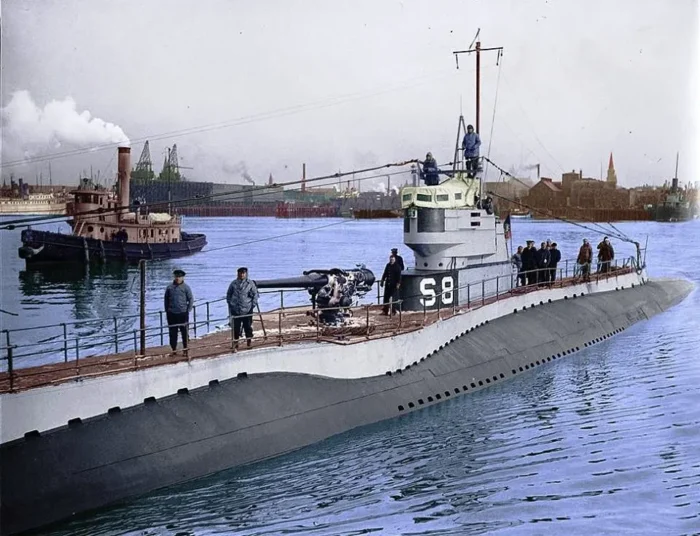
Photo od USS S8 (S-113), one of the Holland Boats, by Boston Herald cameraman Leslie Jones (Boston Public Library coll.) colorized by Postales Navales It was in winter, note the plastic windows canvas fitted over the top frame of the conning tower, wooden deck, and black background markings.
The first US blue water subs
The intent
The United States’ S-class submarines, in the interwar and WW2, known as the S-boats (or “Sugar” boats) were the first class with a true mass production, and of a more versatile and larger design wuth increased performances. They made up in fact, the bulk of the USN submarine service in the interwar, sent to the Caribbeans, Panama, Hawaii, the Philippines, the east and west coast. Too small and slow to be fleet submarines, they nevertheless had been designed as oceanic models, “blue water” operations. All previous classes in the US inventiry indeed had been at first replacements for Torpedo Boats, either for harbor defence, and as time passed, coastal defense. The O class and especially R class were the first intermediate coastal/Oceanic types.
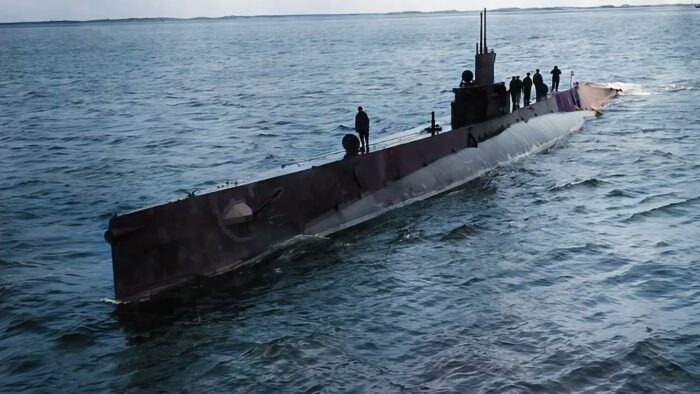
Colorized S-class boat, see related Youtube video below
However the S class were intended to have better surface speed and range, improved habitability and better armament, both on deck and for torpedoes. Notably, a 4 inches/50 gun was made standard, as 5-inches was still considere quite heavy (but there were plans for such upgrade) and tubes were now standardized at 21 inches (R class Lake sub-class had still 18-inches tubes apparently) with 12 torpedoes in reserve.
Construction and naming
The S-class were designed in World War I, but construction started late, and was given to five years to accelerate the process. USS S1 was the first laid down, on 11 December 1917. Indeed the S class design was worked out from April to December. S1 was actually launched shortly before the war ended in October 1918. All without exception missed WWI, being completed, after some hesitations and delays due to the new postwar reevaluations of the USN needs, from 1920 to 1925. So they truly were THE interwar US submarines. Their existence explains also why so few new submarines were built in this period, at least until 1937. The V1 to V9 were experimental boats testing new concepts and working up the future fleet submarines. Even the prewar classes (Salmon, Sargo, Tambor) were modest in production, not in size as they were far larger than the S class and true fleet submarines tailored for the Pacific.
The United States Navy commissioned 51 S-class submarines between 1920 to 1925 but the naming sequence was shaky. USS S-1 (SS-105), was commissioned in 1920 while the last numerically, USS S-51 (SS-162) was commissioned in 1922 but production difficulties encountered by contractors had the sequence completely turned on its head with the actual last commissioned S class being USS S-47 (SS-158) in September, 1925. The hull numbers were thus non sequentil as well. Some boats were delays for many years, mostly due to shortages or manpower, material, shifting priorities and just economic hardships. 14 boats were cancelled, split between a few yards, even though the latter already provisioned parts at their sub-contractors. This put them close to bankrupcy.
The naval Yard that took part in the S class programme were the following:
Electric Boat types (Fore River): USS S1 and then S18 to S29
Lake Type, 1st Group: USS S2
Portsmouth Naval yard (Navy Yard type): S3 to S13
Lake Boats, Bridgeport (Navy Yard type): S14 to S17
Union Iron Works (Electric Boat type): S30 to S41
Electric Boat type, 2nd group: S42 to S47
2nd Lake Type: S48 to S51
However to lake things simpler most sources had them in four groups, sub-classes, if most specialists had them placed in six groups.
I will follow Conway’s approach which does that, adding the prototype USS S2 by Lake as a one-off. And a bit unusually also i will cover global standard specs, and the detai; specs and even the career of those subs along these four groups. Due to the enormity of the 51 boats career studied, i will stick to a barebone overview of their active service an and introduction.
Design of the class
Design Development
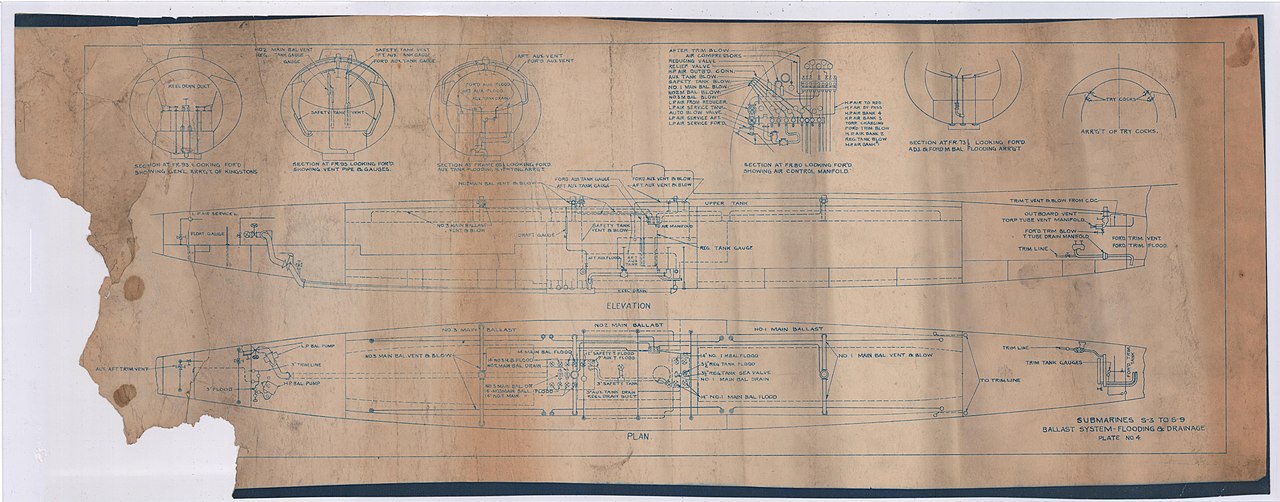
S-class Ballast system flooding drainage
The S class was a radical departure from previous designs, notably by their tonnage alone. They reached 900+ tonnes surfaced for 1230t on average, submerged, versus 570/680 tonnes for the previous R class, and 520/630t for the O-class which were already considered relatively large, so that was twice as much. In dimensions they were close to the later German Type VII, which came in handy in 1941 to simulate these in Atlantic ASW training. So they were in short, the first US oceanic submersibles, designed to leave US coastal waters, and raom the Atlantic and Pacific to some extent. In WW2 standards they were considered unsuccessful for Pacific operations.
They would be built under three different designs, developed respectively by Holland, Lake and the Bureau of construction and repair (BC&R) in early 1917. The General board acquired these three designs later in 1917 and tried to define a standard with one prototype for each, S1 (Holland/Electric Boat), S2 (Lake, Fore River) and 3 (Navy Type, Portsmouth NyD) respectively.
These prototypes were eventualy authorized in Fiscal Year 1918, built to the same specifications, with the Electric Boat and BuC&R designs put into series production in later fiscal year appropriations. There was no chance they would even be completed at that stage, but we have to remember that the allies expected a difficult push into Germany starting in the spring of 1919… The revolution in Berlin and November Armistice were completely unexpected.
The Lake variant was somewhat unsuccessful, which after the disappointment of the R-class by Lake just fuelled the fall of this company and led to its bankrupcy in 1924. The Navy also pressed the company to built their follow-up under Bureau design. These became the Lake type, Group II.
Two designs main designs appeared in construction, with 24 submarines (S18-41) by Holland, 14 (S4-17) by Portsmouth NyD , BuC&R (plus 4 by Lake). Then 10 very similar boats, second Holland series (S42-47) and the S48-51 by BuC&R.
Basic difference (see later) between the Holland and Bureau (BuC&R) designs were in the hull construction, the first single-hulled, the second double-hulled. BuC&R indeed was looking at developments in Europe, and notably the Laurenti type that was tested by the Royal Navy. It was reputed for its greater strenght, allowing deeper dives. Nevertheless, the final diving depth between type was formalized as identical. The third, Lake type, had additional stern TT unlike the two others.
But during discussions in 1917, some insisted they should take part in fleet operations of possible and pushed for the highest surface speed, while others wanted them to be usable as hunter-killers to track down German U-Boats (Holland supported this “faction”) and thus had the best submerged speed and agility if possible. They notably looked at the British R-class subs, arguably the first pure hunter-killer submarines.
They agreed however to have at least the conning tower better profiled and streamlined to achieve the latter goal. For surface speed, there simply was no diesel available that could provide the power required to at least reach battleship speed (21 knots). The “fleet gang” won a new design, the TT class (later Schley class) to fulfull their wet dreams, but this was a disaster. On trials in 1920, these prototypes were outstanding still. If surface speed was on average between 14 and 15 knots, marginally better than the the R class, it was just impossible to reach the desired power with the diesels which were produced in the US at the time.
The acquisition of German diesels by that time would have required to completely review the design at that stage, it was already far too late. But for their submerged speed, they achieved between 12.5 to 13kts, which was just amazing for the time. The submerged top speed in “normal” use was however topped to 11 knots. That reserve of a few knots was considered a margin of safety and survival. The First World War experience showed practicity was however more important than these few knots gain, and in production the conning towers were revised, and made less streamlined but more convenient.
Hull and general design
Being an extrapolation of the R class, they kept the same general outlook with their hull shaped like a splindle, narrow outer hull above, narrow deck apart for the gun platform. There were narrow walkways on both sides of the conning tower with hanbars to transition from the fore to the aft decks. The latter was quite short and ended with a sharp back straight down under. The shape of the tail however varied between boats, especially between Lake and Holland boats. The helmsman post was built over the upper part of the conning tower placed on a base, and the previous canvas cover was now a rigid cover with frames above which could be covered by a tarpaulin. In winter notably, a full tarp with small windows could be strappedon top, keeping some heat from below via the main bridge hatch. The periscopes mountings were aft.
The S class as said above were way heavier and larger than the R or O classes. These were the first to pass the treshold of 1,000 tonnes submerged, a prickle as already this was done in Europe, with some “U-Kreuzer” flirting with 4000 tonnes… They were also much longer and larger that previous boats, and kept the same hanging protection cable strapped between the prow’s tripod and aft’s to go under heavy nets. The deck gun was now the heavy 4-inches/50 caliber (see below), way more capable than the previous 3 inches/50 and fixed permanently on a platform built above the deck, sponsoned to allow the crew to operate on a full traverse.
The underlying principles of this design came from a long way: Intelligence reports were received from 1914 to 1916 already, showing that U-boats operating off Great Britain far exceeded capabilities of the US Navy H, K, L, and N classes. If Great Britain lost the war, those could be able as well to raom the Atlantic and prey in US territorial waters. Requirements for a larger design aligned on these German subs was developed, including the capacity of sailing across the Atlantic if needed. Navy’s specifications at first called for a still conservative 800 tons (standard or surfaced) capable of 11-14 knots (submerged/surfaced) with a range of at least 3400 nautical miles and up to 5400 if needed. The armament was fixed to four 21-inch torpedo tubes but the 4-inch deck gun was a novelty.
As it was considered something of a challenge, trusted sub-builders, Electric Boat (Holland) and Lake were asked to submit their designs albeit to not be taken by surprise and have some leeway in negociations, theNavy this time, and that was a first, ordered a design from its own Navy Yards of Portsmouth via the Bureaiu of Construction and repairs. The Navy wanted to diversify the acquisition process and create some competition to Electric Boat as Lake was already on a downwards slope at that stage.
Still, both Electric Boat and BuC&R designs had been designed less as pure prototype but as preseries in order to order production as soon as practicable.

A Lake Boat, note the much more pronounced hull’s underbelly and odd tail arrangement.
It should be noted that if the new conning towers were made more pratical and larger, its fairwater was also completely redesigned and common to all three series. Previous US submarines had small fairwaters just to reduce drag, improve submerged speed. But when surfaced in the long North Atlantic patrols (which was the norm, not the exception) the crew were frequently seaking wet all the time spent at the helm. They asked for a better protection for the watchstanders. In 1919 captured U-boats showed the Germans considered the problem and designed, large rigid fairwater with permanent grab rails and wave breaker and deflectors which were really efficient to keep water spray away. All so S-boats in construciton or after completion thus were backfitted with an improved and much larger fairwater. This made them far more appreciated by the crews in the interwar as well.
Powerplant
All the boats repeated the powerplants of their forebears, R and O class, albeit with much larger engines, both diesels and electrics, and extra battery cells due to the extra space. The first two boats (Holland S-1 at Quincy, S-30 at San Francisco) in sea trials experienced severe torsional drive train vibrations in their high-speed runs. They reached such a level that the engines basically came completely apart. Investigation showed that crankshafts for these NELSECO 8-EB-15 engines ((an Electric Boat Marine subsidiary) had not a proper diameter (they were basically the same in previous classes) and not only had too much room inside their fittings and lacked the strenght to cope with the power stroke of each cylinder when fired. This gave an excessive torsional twisting and a cascade of side effect with only increasing vibrations.
Production was completely stopped at this stage because these crackshafts were located low in these boats and they needed t be basically gutter to access tand replace them all. This explains the long delays, after launch often of boats laying incomplete in yards. This completed had to stay at a reduced power, waiting for a fix or refit. The Navy Department obtained for the Congress an extra envelope to rebuild engines with a proper crankshaft on all boats. This delays their entry into service but at least cured torsional vibration. In the end, this crackshaft issue delayed the entire serie of 4 years and a half in most cases. It was only common to Electric Boats, neither the Bureau and Lake boats were concerned. The engines were not bad by themselves and served these boats well, once mastered and well maintained.

S-11 top and side, from the plans, cleaned up (author’s).
Still, they horrified Future admiral Hyman G. Rickover (father of the US nuclear subs) when assigned to USS S-48. He spoke of a “faulty, sooty, dangerous and repellent engineering”and dcemented his future views and intransigence toward high engineering standards.
The BuC&R design built by Portsmouth and Lake instead had a MAN diesel engine, or for the Lake boats, a 2-cycle/4-cycle Busch-Sulzer engine. The latter still suffered from design and engineering problems proper to early diesels but still were much more reliable compared to the NELSECO engines.
In terms of performances, the specified speed were respected, 14 knots for the EB designs, 15 on USS S2 (not adopted), 15 also on the Bureau Boats (Portsmouth), 14.5 for the second Holland (EB) serie and the four Lake boats with an average underwater speed of 11 knots “official” for all. This was rather consrvative and repeated the performances of previous R class boats.
However the range was no better. The R class were limited to 4,700 nm at 6.2 knots, whereas the S-class averaged between 3,250 nm and 2,510 nm at the same speed. The exceptions were the Lake boats serie based on the Bureau design (Group II) which managed 5,900 nm at 11 knots…
Armament
Deck Gun: 4-in/50
The O and R class went from a 3 inch (76 mm)/23 caliber gun, non-retractable in later batches to a 3 inch/50 caliber model that became standard. However the S class was upgraded to a 4-inches gun, as part of the discussions in 1917 leading to design a new type of oceanic submersible. The adoption of a gun thay was almost twice the weight of a 3-inches was not a concern as the upscaling of the new hulls, which were perfectly able to cope with the new topweight. Calculations showed however than a 5-inches gun (which some in the Navy preferred) showed they were however not the right size yet. Calculations showed a 2000t boat would be able to have one or two, but since the S-class were not cruisers or fleet submarines, the swap towards a 4-inches gun for surface combat was seen largely enough. Thus new 4-inch (102 mm)/50 caliber deck gun was due to observations that U-boats frequently used their deck guns, and this was a 105 mm model.
The 4-in/50 Mark 9 started to be remarkably unbiquitous, they were installed on the Cassin, Aylwin, O’Brien, Caldwell, Wickes and Clemson class destroyers and oof course all S class subs, but also interwar models such as the USS Dolphin (SS-169) and the Shark (SS-174), Perch (SS-176), Salmon (SS-180) and Balao classes, armed yachts, gunboats, Eagle boats and auxiliaries.
The Gun Weighted 2.725 tons (2.769 mt) for 206.5 in (5.2496 m) in lenght. They were capable of 8-9 rpm, firing a 62.4 – 64.75 lbs. (28.3 – 29.4 kg) complete round, up to 12,000 yards (10,970 m) at 12.4 degrees.
Read More on navweaps
Torpedo Tubes
The R-class were the first US submarines fitted with the new 53 cm tubes with one reload for each tube (eight). The torpedo room was internally painted in white and fairly roomy, to six or eight bunks being setup, and kept brightly white with deck covering in canvass painted a bright green shellac. As for the new, larger torpedo tubes they had often their own barrels white. The tube doors were in brass and well polished. The four torpedoes were stored in racks alongside the bulkhead two on either sides, with two traveling chainfalls running down overhead. The torpedo crew had to find its center of balance with the chainfall and line it up with the tube, then insert it up to the hoisting strap which could be removed and adapter inserted in the tail. It was hooking a block and tackle into it, pulling the rest of the torpedo all the way into the tube.
There was no Torpedo Data calculations done mechanically, and the gyro angle was ordered from the control room, after which a spindle was insterted to set up the angle ordered, then withdrawn before firing. The tube shutters and outer doors were opened manually with forward Trim being used to flood the tube prior opening the outer shutter doors. The same same tank was used to drain the tube after being been fired and outer doors confirmed closed. The torpedo room could be even possibly used as an escape chamber via the tubes. These boats allo has a was a mushroom anchor under the keel, operating from inside the room and called the “submerged anchor”. Its casing was flooded to almost negative buoyancy, being being dropped and leaks were tested.
The torpedoes used were planned at first to be the 1915 Bliss-Leavitt Mark 21, ro to be precise the Bliss-Leavitt 21″ Mark 9 Mod 1B: (Wet-heater for 5,500 yards (5,030 m)/34.5 knots with a 395 lbs. (179 kg) Torpex warhead).
But the bread and butter of this class, that is until replaced by the infamous mark 14, were the Mark 9 Mod 1B (submarine variant), with considerable stocks developed. So they were still around for them, albeit completely obsolete in 1941. At least they were more trusted than the Mark 14.
⚙ specifications Mark 9 Mod 1B TORPEDO |
|
| Weight | 2,377 lbs. (1,078 kg) |
| Dimensions | 196 in (5.004 m) |
| Propulsion | Wet-heater |
| Range/speed setting | 5,500 yards (5,030 m) / 34.5 knots |
| Warhead | 395 lbs. (179 kg) Torpex |
| Guidance | Mark 8 Mod 1 gyro |
In alternative they could use the even shorter 21″ (53.3 cm) Mark 10, the last designed by Bliss at the manufactured by the Naval Torpedo Station at Newport. Entering service in 1818, still the go-to torpoedo for the S class in WW2 instead of the Mark 14, reserved to more recent boats. They existed in two types, Mod 0 and Mod 3*
⚙ specifications Mark 10 TORPEDO |
|
| Weight | 2,050 lbs. (930 kg)/Mod 3: 2,215 lbs. (1,005 kg)* |
| Dimensions | 183 in (4.953 m) |
| Propulsion | Wet-heater |
| Range/speed setting | 5,000 yards/30 knots or 3,500 yards (3,200 m)/36 knots* |
| Warhead | 400 lbs. (181 kg) TNT or 497 lbs. (225 kg) TNT*, 485 lbs. (220 kg) Torpex* |
| Guidance | Mark 13 Mod 1 gyro |
Service of the S-class

S-24 at sea, battling waves
Specs and Career by Sub-Type
Electric boat (Holland) Type, Group I:
The Holland design was approved following sea trials of S1 and leed to an order for the “Group I” (half built also by Union Iron Works) whereas Group IV boats were the same but enlarged. These were single hull designs with ballast tanks contained within the pressure hull. The latter had a less rounded spindle shape as previous designs, while the rudder was placed at the very end of the hull and aft of the propeller screws. They were 33 feet (10.1 m) longer than previous designs and 3 feet 3 inches (1 m) beamer, 2 feet 3 inches (0.7 m) draftier, for a 60% greater displacement than the R class. That enabled a much greater range and larger engines that could provide a better top speed, as well as more torpedo reloads, twelve instead of eight. No thoughs were given to add an extrai pair of tubes yet. They used Nelesco (NLSE) diesels which were barely reliable, but with proper maintenance proved to be durable. They still ran 20 years later in the 1940s.
By default they also carried in the 1920s an SC sonar.
In 1939, all S1 class that survived received a 12.7mm/90 Borwning M2 AA guns in their aft CT platform and the new JK sonar.
In WW2 those still active had an extra 20mm/70 Mk 4 Oerlikon AA installed on their reworked CT, as well as a SJ radar and the new QB sonar. S27, S28 diverged by having the QC sonar instead.
SS129, 134, 140, 146 at the end of the war, received the new Mk 10 Oerlikon AA, kept their Cal.50 M2 HMG, but could be fitted either by the QB or QC or ealier JK sonar.
⚙ S class specs, Electric Boat I |
|
| Displacement | 854 long tons surfaced 1062 long tons submerged |
| Dimensions | 66.9 x 6.30 x 4.80 m |
| Propulsion | 2 shafts NLSE diesels 1200 hp and 2 electric motors 1500 hp |
| Speed | 14 knots (26 km/h; 16 mph) surfaced, 11 knots (21 km/h; 13 mph) submerged |
| Range surfaced/sub. | 168 tons oil, 3,420 nmi at 6.5 knots sufaced |
| Armament | 4× 21 inches* TTs (12 torpedoes), 3 in/50 Mark 9 deck gun |
| Test Depth | 200 ft (60 m) |
| Crew | 38 |
 S1 (1918, SS105)
S1 (1918, SS105)
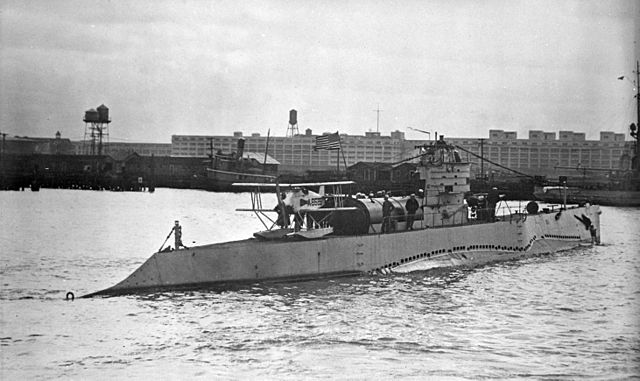
USS S1 was laid down at Yard 296 (Electric Boat) in Fore River (Quincy, Mass.) on December 1917. She was launched on 26 October 1918 and completed in June 1920. S-1 started service in July 1920, shakedown cruising to Bermuda, attached to Submarine Division 2 (SubDiv 2) and training off Connecticut and New England until 1923.
On 2 January, she was reassigned to SubDiv Zero for experimental tests and she had winter maneuvers in the Caribbean Sea and Back to New London. She tested also a submarine-borne observation and scouting later that year, 1923 with a steel capsule mounted abaft her conning tower, housing a small collapsible Martin MS-1 seaplane. It was rolled out and assembled, then launched by trimming the sub down. Tests were concluded in 1926 with the alternative all-metal Cox-Klemin XS-1 and XS-2. A final official test was done before officials on 28 July 1926, on at New London. This showed however the concept unworkable, and all was removed. The hangar capsule later became the prototype for the McCann Rescue diving bell intended for sunken submarines.
S-1 became flagship for SubDiv 2 until July 1927 and joined SubDiv 4 for operational cruises to Panama until 1930, stopping at Cristobal, Coco Solo, Cartagena, Kingston, or Guantánamo Bay when not in New England.
In January 1931 she was reassigned to Pearl Harbor until 1937 with SubDiv 7, SubRon 4, and from July 1932 to July 1933 SubDiv 14 reserve. In august she was back at SubDiv 7and sialed for Philadelphia by May 1937 for overhaul and deactivation, decommissioned on 20 October. She was reactivated and recommissoned on 16 October 1940 at Philadelphia, made a shakedown cruise at Bermuda, then a second cruise which caught her there on 7 December 1941. Uder lend-lease she was prepared for transfer to Britain, effective on 20 April 1942, stricken on 24 June.
She became HMS P.552, usied to train British submariners and escort crews to ASW. While in Durban, Natal in January 1944 she was declared worn out and in too poor cnditions for effective service, unseaworthy. Administratively returned to Durban on 16 October she was stripped and sold for BU on 14 September.
 S18 (1920, SS123)
S18 (1920, SS123)
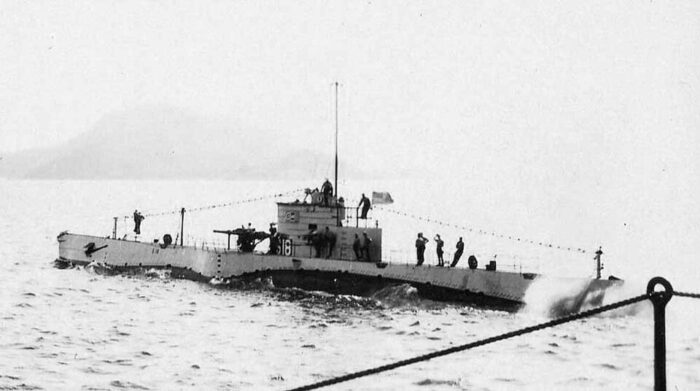
S18 was laid down at Yard 309, Bethlehem, Quincy on august 1918, launched 29 April 1920, and completed in April 1924. From 1924 to 1929, she operated out of New London in Connecticut and off the New England coast, but with annual deployments to the Caribbean for winter maneuvers and Fleet Problems. She was transferred to the Pacific Fleet in from 24 May 1930, operating off the California coast and from Pearl Harbor from 7 December 1930. For 11 years based her, she operated in training missions, until sent back home on September 1941, proceeding to the West Coast. On 7 December she was ordered for the Aleutian Islands as part of Submarine Division 41, from mid-January 1942.
Until March 1942 she was in defensive patrols while waiting for the completion of the new Dutch Harbor base at Amaknak Island, Unalaska. In mid-March 1942, she headed for San Diego foran overhaul mid-May. Back to the Aleutians she was ordered en route on 29 May to go the southern approaches to Umnak Pass as the Japanese were expected there. On 2 June she took up her patrol station and a day after learned about an air raid on Dutch Harbor and later, landings at Kiska and Attu. Fog, rain, poor radio reception, lacking radar and fathometer or deciphering equipment she still remained until 10 June in submerged daylight operations up to 19 hours a day, durfacing by night for 5 hours. She returned to Dutch Harbor on the 11th, and on the 13th she patrolled west and north of Attu, and north of Kiska in appealing weather which only added to numerous wear and tear defects and design limitations. On 29 June she sighted a submarine but was unable to close. Back to Dutch Harbor, her CO requested a betetr sonar and radar.
From 15 July to 2 August 1942 she patrol off Kiska until ordered back to San Diego. In October 1942 she was back to the Aleutians. On 22 October she left Dutch Harbor for a patrol around Kiska and on 3 November 1942, was recalled. On 12 November she was underway again but on 15 November a crack in the starboard main engine housing forced her back for repairs on the 20th. On the 30th she was back on patrol off Kiska, Kiskinato, Agattu, and Attu. On 22 December she lost her starboard stern plane and depth control so she returned to Dutch Harbor with repairs until she was back on patrol from 7 January 1943 over 28-day patrol, off Attu and the Semichi Islands. On 4 February she was ordered back to San Diego for overhaul, and when completed, she was assigned to training off San Diego and with the West Coast Sound School until mid-August 1945 (1 battle star for the Aleutian campaign). By 29 October she was decommissione, struck on 13 November adn sold for BU on 9 November 1946 to Salco Iron and Metal Co.
 S19 (1920, SS124)
S19 (1920, SS124)
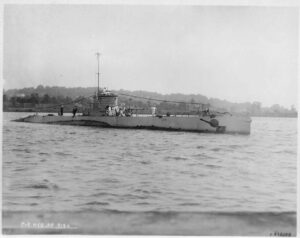 S19 was laid down at 310 Yard, Bethlehem (same for the others unless stated otherwise) on August 1918, launched on 21 June 1920 and completed in August 1921. She operated off the northeastern coast from 1923 to 1930 with fleet exercises off Panama every year. Hoever in heavy fog early on 13 January 1925, she ran aground off Chatham, Massachusetts, southern coast of Cape Cod, pushed by strong winds and heavy seas off course. She came from Portsmouth NyD Kittery in Maine after overhaul,en route to New London. USCG cutters Tampa and Acushnet went in assistance, but heavy seas made it impossible to pass a line. It resumed on 14 January with a party from the Nauset, Massachusetts, boarding and attaching a line so by the morning of 15 January, her crew had been evacuated and tugging commenced, and she was freed from the shoal, repaired and later returned to service. She was back in Atlantic operations until 22 October 1930 and left for the Pacific, Pearl Harbor, starting service from 7 December 1930 over three years until decommissioned on 10 February 1934.
S19 was laid down at 310 Yard, Bethlehem (same for the others unless stated otherwise) on August 1918, launched on 21 June 1920 and completed in August 1921. She operated off the northeastern coast from 1923 to 1930 with fleet exercises off Panama every year. Hoever in heavy fog early on 13 January 1925, she ran aground off Chatham, Massachusetts, southern coast of Cape Cod, pushed by strong winds and heavy seas off course. She came from Portsmouth NyD Kittery in Maine after overhaul,en route to New London. USCG cutters Tampa and Acushnet went in assistance, but heavy seas made it impossible to pass a line. It resumed on 14 January with a party from the Nauset, Massachusetts, boarding and attaching a line so by the morning of 15 January, her crew had been evacuated and tugging commenced, and she was freed from the shoal, repaired and later returned to service. She was back in Atlantic operations until 22 October 1930 and left for the Pacific, Pearl Harbor, starting service from 7 December 1930 over three years until decommissioned on 10 February 1934.
 S20 (1920, SS125)
S20 (1920, SS125)
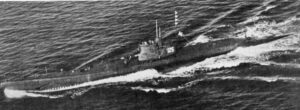 S20 was laid down at yard 311 in August 1918, launched on 9 june 1920 and completed on November 1922. She was rebuilt in 1924 with a larger bow like USS V-1 to improve seakeeping and blisters on the upper hull for more fuel. S-20 experimented also a high-speed geared-drive 600 hp (447 kW) MAN diesel, replacing her starboard engine in 1931. The next year it was replaced by a prototype diesel-electric plant with a US built MAN 635 hp (474 kW) 16-cyl. engine capable of higher speed, driving an electrical generator 16VM1 from Electric Boat. She trained along the northeastern coast from New London from 1922 to 1929, visiting Panama in March 1923, Saint Thomas in February 1924, Kingston in March 1927, wit frequent station in the Panama Canal area yearly. On 7 November 1930 she left Coco Solo for Pearl Harbor, starting service there from 7 December 1930. On 20 February, March 1932 and until April 1933 she was based off Mare Island, then San Diego until 1934. Departing on 15 March she was based to New London until December 1941, in the test and evaluation division. Se also cruised to Cuba in 1938, 1940, Panama in 1939 under Lieutenant John P. Cromwell, future posthumous MoH on USS Sculpin (SS-191). From 1941 to 1942 under Lt. Samuel David Dealey and then from December 1942 yo July 1945 she patorlled from New London with training at Casco Bay in Maine every year. She was disposed of at New London on 2 July 1945, decommissioned on 16 July at Philadelphia, struck on 25 July, sold for BU on 22 January 1946.
S20 was laid down at yard 311 in August 1918, launched on 9 june 1920 and completed on November 1922. She was rebuilt in 1924 with a larger bow like USS V-1 to improve seakeeping and blisters on the upper hull for more fuel. S-20 experimented also a high-speed geared-drive 600 hp (447 kW) MAN diesel, replacing her starboard engine in 1931. The next year it was replaced by a prototype diesel-electric plant with a US built MAN 635 hp (474 kW) 16-cyl. engine capable of higher speed, driving an electrical generator 16VM1 from Electric Boat. She trained along the northeastern coast from New London from 1922 to 1929, visiting Panama in March 1923, Saint Thomas in February 1924, Kingston in March 1927, wit frequent station in the Panama Canal area yearly. On 7 November 1930 she left Coco Solo for Pearl Harbor, starting service there from 7 December 1930. On 20 February, March 1932 and until April 1933 she was based off Mare Island, then San Diego until 1934. Departing on 15 March she was based to New London until December 1941, in the test and evaluation division. Se also cruised to Cuba in 1938, 1940, Panama in 1939 under Lieutenant John P. Cromwell, future posthumous MoH on USS Sculpin (SS-191). From 1941 to 1942 under Lt. Samuel David Dealey and then from December 1942 yo July 1945 she patorlled from New London with training at Casco Bay in Maine every year. She was disposed of at New London on 2 July 1945, decommissioned on 16 July at Philadelphia, struck on 25 July, sold for BU on 22 January 1946.
 S21 (1920, SS126)
S21 (1920, SS126)
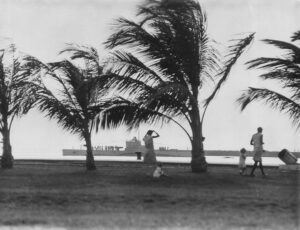 S21 was laid down at Yard 312 in December 1918 and launched on 18 August 1920, August 1921. In 1921–1928 she operated from New London, then Groton from 14 September 1923, training along the northeastern coast with stops in Panama, Saint Thomas (Virgin Islands), Trinidad in 1924, Hawaii from 27 November 1924 to 25 May 1925 and back to New London in July. More deployments in 1926-28 and she took the first U.S. gravity measurements at sea in 1926, for the Carnegie Institution for Science. She was using a gravimeter designed by Dr. Felix Andries Vening Meinesz, requiring stability and lack of motion while submerged. She worked with a team from the National Academy of Sciences, USC Geodetic Survey, US Naval Observatory, providing special chronometers for the gravimetric observations as well as the USN Hydrographic Office and Meinesz himself to setup the device, with Elmer B. Collins to represent Hydrographic Office. While underwater, the submarine was assisted by two Eagle-class patrol craft, Eagle 35 and Eagle 58 used as tenders. She departed from Hampton Roads on 4 October 1928, sailed ti Key West, Galveston, Guantanamo Bay, the Virgin Islands, Puerto Rico, and back to Hampton Roads on 30 November 1928. 49 gravity measurement stations were taken, with sonic depth sounding. A chart wa slater produced by the U.S. Navy Hydrographic Office. This was used to determine also the shape of the Earth, and detect negative gravity anomalies. Later this inspired the Navy-Princeton gravity expedition to the West Indies on S-48 and in 1936–1937 with the the Gravimetric Survey Expedition using USS Barracuda (SS-163).
S21 was laid down at Yard 312 in December 1918 and launched on 18 August 1920, August 1921. In 1921–1928 she operated from New London, then Groton from 14 September 1923, training along the northeastern coast with stops in Panama, Saint Thomas (Virgin Islands), Trinidad in 1924, Hawaii from 27 November 1924 to 25 May 1925 and back to New London in July. More deployments in 1926-28 and she took the first U.S. gravity measurements at sea in 1926, for the Carnegie Institution for Science. She was using a gravimeter designed by Dr. Felix Andries Vening Meinesz, requiring stability and lack of motion while submerged. She worked with a team from the National Academy of Sciences, USC Geodetic Survey, US Naval Observatory, providing special chronometers for the gravimetric observations as well as the USN Hydrographic Office and Meinesz himself to setup the device, with Elmer B. Collins to represent Hydrographic Office. While underwater, the submarine was assisted by two Eagle-class patrol craft, Eagle 35 and Eagle 58 used as tenders. She departed from Hampton Roads on 4 October 1928, sailed ti Key West, Galveston, Guantanamo Bay, the Virgin Islands, Puerto Rico, and back to Hampton Roads on 30 November 1928. 49 gravity measurement stations were taken, with sonic depth sounding. A chart wa slater produced by the U.S. Navy Hydrographic Office. This was used to determine also the shape of the Earth, and detect negative gravity anomalies. Later this inspired the Navy-Princeton gravity expedition to the West Indies on S-48 and in 1936–1937 with the the Gravimetric Survey Expedition using USS Barracuda (SS-163).
She resumed training from New London and Panama Canal in 1929 and 1930 and transited the canal on 22 October 1930 for California and Pearl Harbor, present on 7 December 1930 and operating from there until 1938, in reserrve for 1932-1934. She left in October 1938 for California, Panama, and Philadelphia on 11 December then an overhaul and returned to New London on 25 March 1939. She remained with a skeleton crew from June 1939 until 1 September 1940, then full commission so on 9 December 1941 she returned to patrol the Panama Canal Zone and Pacific Ocean approaches until May 1942. She took part in SAR operations for USS S-26 lost on 24 January after being rammed by PC-460 by night. In June 1942 she was back to New London and on 14 September, was decommissioned, transferred to RN as HMS P.553, served there until returned at Philadelphia on 11 July 1944 and used as target, sunk in 150 feet (46 m) in the Atlantic off Cape Elizabeth in Maine on 23 March 1945.
 S22 (1920, SS127)
S22 (1920, SS127)
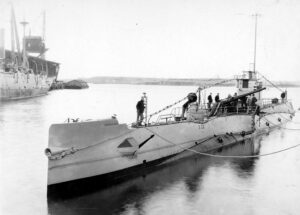 S22 was laid down at Yard 313 in Jan 1919, launched 15 July 1920, completed on June 1924 (delays). She served to the northeastern coast from New London from 1924 through 1930, but also visited Hawaii from 27 April to 25 May 1925 and operated in the Panama Canal Zon in 1926 also visiting Kingston, Jamaica, from 20 to 28 March 1927. She was on patrol at Panama in 1928, 1929, and 1930.
S22 was laid down at Yard 313 in Jan 1919, launched 15 July 1920, completed on June 1924 (delays). She served to the northeastern coast from New London from 1924 through 1930, but also visited Hawaii from 27 April to 25 May 1925 and operated in the Panama Canal Zon in 1926 also visiting Kingston, Jamaica, from 20 to 28 March 1927. She was on patrol at Panama in 1928, 1929, and 1930.
She left New London on 5 January 1931 for Pearl Harbor, operational there from 25 April and until 1938. She left Pearl Harbor on 15 October for New London (11 December) and joined a test and evaluation division, also training Naval Academy midshipmen at Annapolis or the diving school at Piney Point in Maryland and Key West from December 1940 to May 1941. She had an overhaul and was srnt to patrol the Panama Canal appriaches from January to March 1942, the back too New London on 17 April. Decommissioned on 19 June she was transferred to the Royal Navy as HMS P.554, active for training until returned to Philadelphia on 11 July 1944, used as a sonar target in New Londo and with the Naval Experimental Facility at Minas Basin in Nova Scotia.
Stricken in August 1945 she was sold for scrap on 16 November.
 S23 (1920, SS128)
S23 (1920, SS128)
S23 was laid down at Yard 314, in Jan. 1919, launched on 27 October 1920 and completed in August 1923. Initially assigned to SubDiv 11, Control Force at New London until 1931. She moved south for winter and spring exercises every year. From 1925 she took part in Fleet Problems, rom the Caribbean to the Pacific and in 1931, she was transferred to Parl Harbor, starting operation from 5 January 1931, and Fleet Problem XII. She was assigned to SubDiv 7 for ten years. In June 1941 this became SubDiv 41, and, in September she departed for California and an overhaul followed by West Coast patrols until December and prepped for the Aleutian Islands. She received radiant-type heaters in San Diego and the crews received waterproof clothing, ski masks, while she was fitted for wartime service before departing in January 1942 for Dutch Harbor, Amaknak, Unalaska.
First patrol: From 7 February heavy seas and poor visibility. 10 February she jettisoned torn sections of the superstructure. 13 February she had sailors injured on deck by heavy seas. She patrolled the great circle route from Japan and was back on 17 February. She was then ordered back to San Diego for overhaul and sound school duty, and had electrical, heating, and communications, fathometer, radar, keel-mounted sonar requested but not installed after her fourth patrol. She departed back on 20 May for the Aleutians via Port Angeles in Washington and started operations from 29 May 1942, west of Unalaska to guard for a Japanese attack. On 2 June 1942 she had two men injured by heavy weather again and returned to Dutch Harbor for medical treatment. She was there on 3 June 1942 during the Japanese attack, and after the first raid she cleared the harbor and remained on her patrol line until 11 June, back, replenished and sent southeast of Attur, and for 19 days, hunted for Japanese logistic ships and warships. But between her slow speed and poor maneuverability all attacked failed but on 17 June 1942, firing but missing a tanker. On 4 July 1942 she was back at Dutch Harbor.
Third patrol was from 15 July to 18 August on the Attu area. On 6 August she was diverted closer to Kiska in support of a bombardment of the island and on 9 August 1942, returned to her patrol area. Her 4th patrol was eight days after her return from 28 August, actiing as protective scout during the occupation of Adak. On 16 September she was recalled to San Diego for upkeep and sound school duty but return from 7 December 1942 to Unalaska, starting another 5th patrol from 17 December. On the 22th she was off western Attu and a day later was ordered off Paramushiro, northern end of the Kuril Islands. On 26 December underway however her stern plane operating gear broke and she headed back for Dutch Harbor. Her propellers were damaged and the rudder gear train as well, while in severe snow and ice storms after 3 January 1943 but she arrived 3 days later for repairs, with equipment salvaged from USS S-35, S-23 in Dutch Harbor and drydock in Kodiak. On 28 January she left for the Attu area, 21 days on station with emergency repairs on 6-7 February of her port main motor control panel. She was back on 26 February.
Sixth patrol started on 8 March 1943 to the Kamchatka Peninsula from 14 March. She was damaged by floes with ice 2.5 to 3 feet (0.75 to 0.9 m) thick, trying to at least target the Japanese fishing fleet. Past Cape Kronotsky on 16 March 1943 she arrived at Cape Lopatka on the 19th and returned for the Aleutians trying to hunt the IJN supply lanes from the Kuril. On 26 March she was back off Attu and on 31 March departed back for Dutch Harbor and in April to San Diego and an extensive overhaul, ready by the fall of 1943, now assigned to training with the sound school until August 1945. On 11 September she headed for San Francisco, decommissioned on 2 November, struck 16 November, sold to Salco Iron and Metal Co. on 15 November 1946.
 S24 (1922, SS129)
S24 (1922, SS129)
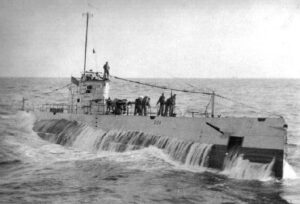 S24 was laid down at Yard 315 in Nov. 1918, launched on 27 June 1922 and completed in August 1923. She ws based at New London in 1923-1924, but visited Saint Thomas (Virgin Is.) by February 1924, Trinidad in March, Panama in April Hawaii until May 1925 but later to San Diego, San Pedro, Mare Island until 1930, with deployements to the Panama Canal area each February-March in 1926, and Hawaii in 1927-1928, Panama 1929, Hawaii 1929, San Diego she departed later for Pearl Harbor, arrived on 12 December 1930, operated there until 15 October 1938 and sent back to New London. She served there from 4 January 1939 with a partial crew, then in full duty from 1st July 1940 and New London until December 1941. She was near the Panama Canal by late December 1941 until May 1942, then New London from 21 May 1942, decommissioned on 10 August 1942 and transferred to the Royal Navy as HMS P555, active from October 1942 as part of the 7th Submarine Flotilla in Holy Loch for training new submarine officers and crews and ASW. She was decommissioned in May 1944, returned in December, struck, scuttled in the English Channel off Portland Bill, 28 April 1947 after being sued as sonar target (date disputed).
S24 was laid down at Yard 315 in Nov. 1918, launched on 27 June 1922 and completed in August 1923. She ws based at New London in 1923-1924, but visited Saint Thomas (Virgin Is.) by February 1924, Trinidad in March, Panama in April Hawaii until May 1925 but later to San Diego, San Pedro, Mare Island until 1930, with deployements to the Panama Canal area each February-March in 1926, and Hawaii in 1927-1928, Panama 1929, Hawaii 1929, San Diego she departed later for Pearl Harbor, arrived on 12 December 1930, operated there until 15 October 1938 and sent back to New London. She served there from 4 January 1939 with a partial crew, then in full duty from 1st July 1940 and New London until December 1941. She was near the Panama Canal by late December 1941 until May 1942, then New London from 21 May 1942, decommissioned on 10 August 1942 and transferred to the Royal Navy as HMS P555, active from October 1942 as part of the 7th Submarine Flotilla in Holy Loch for training new submarine officers and crews and ASW. She was decommissioned in May 1944, returned in December, struck, scuttled in the English Channel off Portland Bill, 28 April 1947 after being sued as sonar target (date disputed).
 S25 (1922, SS130)
S25 (1922, SS130)
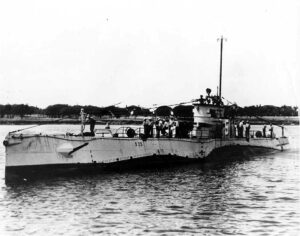 S25 was laid down on October 1918, launched 29 May 1922, commissioned in July 1923. She operated from New London in Connecticut by 1923 and took part in the winter maneuvers in the Caribbean and Panama Canal Zone in January-April 1924, then assigned to the West Coast, Southern California until 1931 with Fleet Problems and division exercises off Panama or Hawaii. She left San Diego on 15 April 1931 for Pearl Harbor, based here until 1939. She departed for the East Coast on 16 June 1939, New London on 25 August 1939. By February 1940 she was reassigned at the test and evaluation division at New London. By December 1940 she sent to Key West for training services until May 1941, then back to New London and prepared for transfer to the RN under Lend-Lease, decommissioned on 4 November 1941, renamed HMS P.551 and loaned to the Polish Navy as ORP Jastrząb under Lieutenant Commander Bolesław Romanowski. During an Allied convoy escort near Norway, Jastrzab strayed some 100 nautical miles (190 km; 120 mi) off her proper course and on 2 May 1942 was mistakenly sunk by HMS St Albans (ex-USS Thomas (DD-182)) and HMS Seagull.
S25 was laid down on October 1918, launched 29 May 1922, commissioned in July 1923. She operated from New London in Connecticut by 1923 and took part in the winter maneuvers in the Caribbean and Panama Canal Zone in January-April 1924, then assigned to the West Coast, Southern California until 1931 with Fleet Problems and division exercises off Panama or Hawaii. She left San Diego on 15 April 1931 for Pearl Harbor, based here until 1939. She departed for the East Coast on 16 June 1939, New London on 25 August 1939. By February 1940 she was reassigned at the test and evaluation division at New London. By December 1940 she sent to Key West for training services until May 1941, then back to New London and prepared for transfer to the RN under Lend-Lease, decommissioned on 4 November 1941, renamed HMS P.551 and loaned to the Polish Navy as ORP Jastrząb under Lieutenant Commander Bolesław Romanowski. During an Allied convoy escort near Norway, Jastrzab strayed some 100 nautical miles (190 km; 120 mi) off her proper course and on 2 May 1942 was mistakenly sunk by HMS St Albans (ex-USS Thomas (DD-182)) and HMS Seagull.
 S26 (1922, SS131)
S26 (1922, SS131)
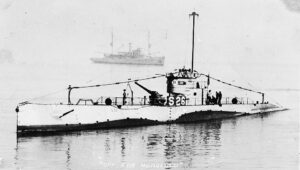 S26 was from yard 317 on November 1919, launched on 22 August 1922, completed on October 1923. She operated from New London from 1923 to 1925, with visits to St. Thomas, Trinidad in 1924, Hawaii in 1925 and California, operating from Mare Island, San Diego, San Pedro and deployed in the Panama Canal area in 1927, visited Hawaii in 1927 and 1928, Panama in 1929, with visits to Hawaii in 1929 and 1930. She left San Diego on 1 December 1930 for Pearl Harbor, Hawaii, deployed here until 15 October 1938, and back to New London from 25 March 1939, in “commission in reserve” with a small crew in April, full duty from July 1940. She had hydrogen tests at Washington, D.C. She departed New London on 10 December for Coco Solo, Panama and a first war patrol to the Pacific Ocean off Panama. On the night of 24 January 1942, she departed Balboa, Panama for a second war patrol in the same division as USS S-21 (SS-126), USS S-29 (SS-134), and USS S-44 (SS-155), under escort by PC-460 (USS Sturdy (PC-460)) to avoid being mstaken by enemy ships and aircraft.
S26 was from yard 317 on November 1919, launched on 22 August 1922, completed on October 1923. She operated from New London from 1923 to 1925, with visits to St. Thomas, Trinidad in 1924, Hawaii in 1925 and California, operating from Mare Island, San Diego, San Pedro and deployed in the Panama Canal area in 1927, visited Hawaii in 1927 and 1928, Panama in 1929, with visits to Hawaii in 1929 and 1930. She left San Diego on 1 December 1930 for Pearl Harbor, Hawaii, deployed here until 15 October 1938, and back to New London from 25 March 1939, in “commission in reserve” with a small crew in April, full duty from July 1940. She had hydrogen tests at Washington, D.C. She departed New London on 10 December for Coco Solo, Panama and a first war patrol to the Pacific Ocean off Panama. On the night of 24 January 1942, she departed Balboa, Panama for a second war patrol in the same division as USS S-21 (SS-126), USS S-29 (SS-134), and USS S-44 (SS-155), under escort by PC-460 (USS Sturdy (PC-460)) to avoid being mstaken by enemy ships and aircraft.
All four submarines patrolled surfaced without navigation lights to reduce detection chances but PC-460 at forst 1,500 yards (1,370 m) ahead of S-21 made a visual signal at 22:10 for that she intended to make a 180-degree turn to starboard and return to port but it was potted only by S-21. PC-460 executed her turn and stumbled upon the unsuspecting S-26, 2,000 yards (1,830 m) behind S-21. It was too close range to avoid collision. She was rammed by PC-460 even though her captain put her engines full astern, failing, so she continued on her momentum. Evasive action on both sides were too late. S24 was gushed in her starboard with a large hole in her presure hull, massive flooding while she roll, throwing threemen on her bridge overboard. She rapdily sank by the bow in less than a minute down to 300 feet (91 m), 14 nautical miles (26 km; 16 mi) west of San Jose Light with all men onboard. The survivors, shoked, were her CO, XO and a lookout. Rescue operations commenced on 25 January 1942, with divers making 25 dives to the wreck but hoped to find men alive evaporated. She still lies here, a protected war grave…
 S27 (1922, SS132)
S27 (1922, SS132)
S27 was laid down at Yard 318 on April 1919, launched on 18 October 1922, completed on January 1924. She was wrecked on 19 june 1942. Full logs to come soon.
 S28 (1922, SS133)
S28 (1922, SS133)
S28 was laid down at yard 319 in April 1919, launched on 20 Sept. 1922 and cmpleted on Dec. 1923. She foundered on 4 July 1944. Full logs to come soon.
 S29 (1922, SS134)
S29 (1922, SS134)
S29 was laid down at Yard 320 in April 1919, launched on 9 November 1922, launched on May 1924, she was sent in lend lease to the RN as P556 between June 1942 and Jan 1946, stricken. Full logs to come soon.
 S30 (1918, SS135)
S30 (1918, SS135)
S30 was the first laid down at Yard 201, Union Iron Wks (all that follows) in San Francisco on April 1918, launched on 21 November 1918 and completed in October 1920. She was stricken in October 1945. Full logs to come soon.
 S31 (1918, SS136)
S31 (1918, SS136)
S31 was laid down at yard 202 in April 1918, launched on 28 December 1918 and completed in May 1922. Stricken in November 1945. Full logs to come soon.
 S32 (1919, SS137)
S32 (1919, SS137)
S32 was laid down at Yard 203 in April 1918, launched on 11 Jan 1919 and completed in June 1922. She was stricken in November 1945. Full logs to come soon.
 S33 (1918, SS138)
S33 (1918, SS138)
S33 was laid down at Yard 204 on June 1918, launched in Dec. 1918 and completed in April 1922. She was stricken 11.1945. Full logs to come soon.
 S34 (1919, SS139)
S34 (1919, SS139)
S34 was laid down at yard 205 in May 1918, launched 13 Feb. 1919 and completed in July 1922, stricken in November 1945. Full logs to come soon.
 S35 (1919, SS140)
S35 (1919, SS140)
S35 was laid down at Yard 206 in july 1918, launched 27 Feb. 1919 and completed in August 1922. Sunk as target in 4 April 1946. Full logs to come soon.
 S36 (1919, SS141)
S36 (1919, SS141)
S36 was laid down at Yard 207 by Dec. 1918, launched on 3 June 1919 and completed in April 1923. She was scuttled on 21 Jan 1942. Full logs to come soon.
 S37 (1919, SS142)
S37 (1919, SS142)
S37 was laid down at Yard 208 in Dec. 1918, launched 20 June 1919, completed in July 1923. She was sunk as target on 20 Feb. 1945. Full logs to come soon.
 S38 (1919, SS143)
S38 (1919, SS143)
S38 wa slaid down in Jan 1919, launched 17 June 1919 and comp. May 1923. She was stricken 1.1945. Full logs to come soon.
 S39 (1919, SS144)
S39 (1919, SS144)
S39 was laid down at Yard 210 in jan 1919, launched 2 July 1919 and completed in Sept. 1923. She was wrecked 14.8.1942. Full logs to come soon.
 S40 (1921, SS145)
S40 (1921, SS145)
S40 was lmaid down at yard 211 in Bethlehem, San Francisco on March 1919, launched 5 Jan 1921 and completed in Nov. 1923. She was stricken 11.1945. Full logs to come soon.
 S41 (1921, SS146)
S41 (1921, SS146)
S41 wa slaid down in Aprol 1919, launched 21 Feb. 1921 and completed in Jan 1924, stricken 2.1946. Full logs to come soon.
Lake Type prototype:
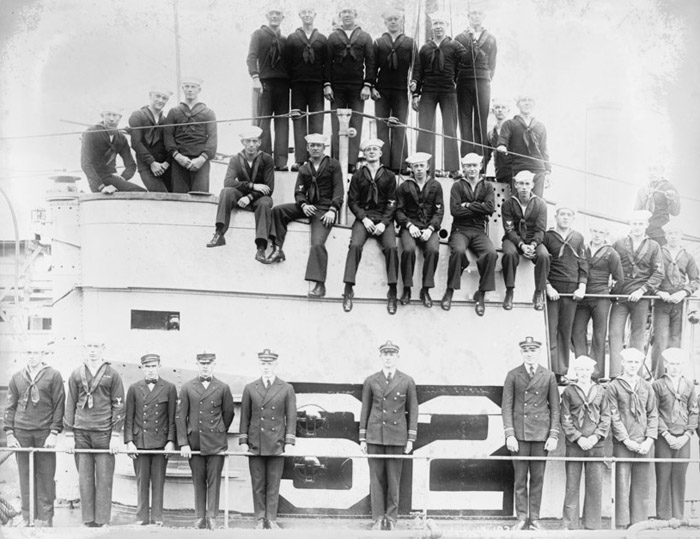
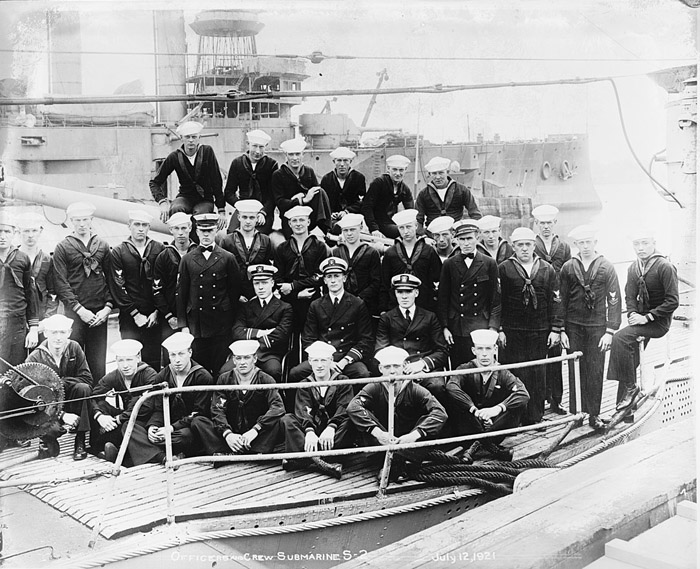
The crew of USS S2 taking the pose. Note in the first they are not looking particularly thrilled to serve in this boat… In the second, note the large size of the conning tower, unprecedented in US Submarine construction.
USS S-2 (SS-106) was the prototype of the “Lake-type” S-class submarine of the United States Navy. (S-1 was the “Holland-type” prototype and S-3 the “Government-type”). The Lake design jad a modified double hull type, with the ballast tanks wrapped around the inner pressure hull, whuch explained her pronounced “fat belly”. Their stern ended in a flat “shovel” which procured the stern with better buoyancy and reduced roll when surfaced. The rudder was however very different, mounted beneath the stern with the whole pivot structure supporting the stern diving planes. The superstructure atop the boat was partially watertight in order to keep extra buoyancy as a safety margin. Sea trials however showed they ploughed heavily underway in formed seas, so for the following production boats, Lake mobified the buoyancy by adding an extra tank to the bow, ending in a “humped appearance”. In the enbd look asthetically far less appealing than Government or Holland boats. Worst still, they suffered from poor maneuverability, whereas the focus on underwater performance made them overcomplicated to manage and with a potentially larger crew. The powerplant was also unreliable. They were soon unpopular, so much so that the The Navy declined it for mass production. The experience remained limited to S2.
⚙ S class specs, Lake Boat I (USS S2) |
|
| Displacement | 800 long tons surfaced, 977 long tons submerged |
| Dimensions | 207 ft x 19 ft 8 in x 16 ft 1 in (63.1 x 6 x 4.9 m) |
| Propulsion | 2× 900 bhp Busch-Sulzer diesels, 2× 600 hp Diehl EM, 120-cell batt. |
| Speed | 15 knots surfaced, 11 knots submerged |
| Range surfaced/sub. | |
| Armament | 4× 21 inches TTs (12 torpedoes), 3 in/50 deck gun |
| Test Depth | 200 ft (60 m) |
| Crew | 38 |
 S2 (1919)
S2 (1919)
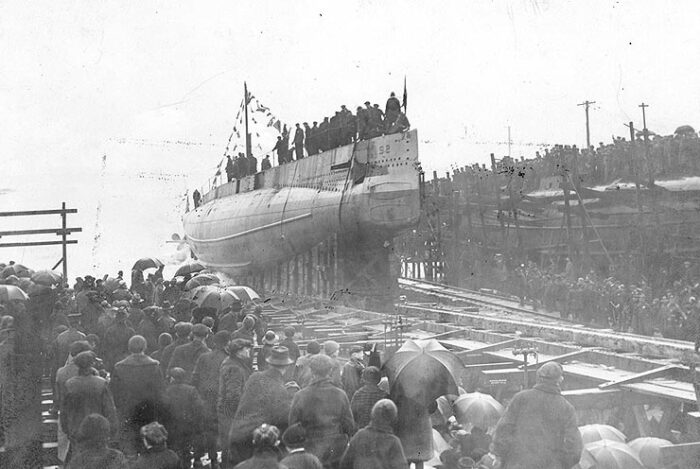
S2 keel was laid down on 30 July 1917 at Lake Torpedo Boat Company, Bridgeport, Connecticut. She was launched on 15 February 1919 and commissioned on 25 May 1920. She was tested off Portsmouth in New Hampshire on 22 July 1921 with the Submarine Divisions 18 and 12 for the longest US submarine cruise ever, via Panama Canal to Pearl Harbor and Cavite and Luzon in the Philippines, to test a deployment from the Atlantic to the far east.
These two divisions stayed at the Cavite Naval Station for three years from December 1921, stopping at Shanghai, Yantai, Qinhuangdao, Qingdao, Amoy, or Wusong. On 29 October 1924, they departed all (but not S2) for the west coast. On 5 November S2 was indeed placed in reduced commission and reserve with a skeleton crew for maintenance and readiness, until 5 May 1928, the recommissioned.
She spent the summer patorlling in the China sea and Philippines with a returned to Philadelphia, not for overhaul, but inactivation. Leaving the Philippines on 27 April 1929 via Guam, Pearl Harbor, and Panama she arrived on 5 August, and was decommissioned on 25 November, stripped, and stricken in 1931, sold for BU on 14 September.
The Navy Yard Type:
The BuC&R design (S-3 prototype) like the Lake boats had a full double hull and integrated design features from Electric Boat and Lake. S3 was the largest as 231 feet long and a bit wider with a battery contained in single, large compartment forward of the control room. This made her long and sleek, so potentially faster. The stern was marked by a sharp vertical “chisel” after the deck’s end, with the rudder and stern dive planes ventrally mounted behind the propellers. From the Group II onwards, on the last four boats, plus four Group IV boats had a single stern torpedo tube as a test. Group IV were also longer but with reduced draft.
⚙ S class specs, Navy Yard |
|
| Displacement | 497 long tons (505 t) surfaced 652 long tons (662 t) submerged |
| Dimensions | 175 ft x 16 ft 7 in x 13 ft 11 in ( x 5.05 x 4.24 m) |
| Propulsion | 2× 500 hp (373 kW) Busch-Sulzer diesels, 2× 400 hp (298 kW) Diehl EM, 120-cell batt. |
| Speed | 14 knots (26 km/h; 16 mph) surfaced, 11.4 knots (21.1 km/h; 13.1 mph) submerged |
| Range surfaced/sub. | 4,700 nmi at 6.5 knots sufaced |
| Armament | 4× 21 inches* TTs (8 torpedoes), 3 in/50 deck gun |
| Test Depth | 200 ft (61 m) |
| Crew | 33 |
 S3 (1919)
S3 (1919)
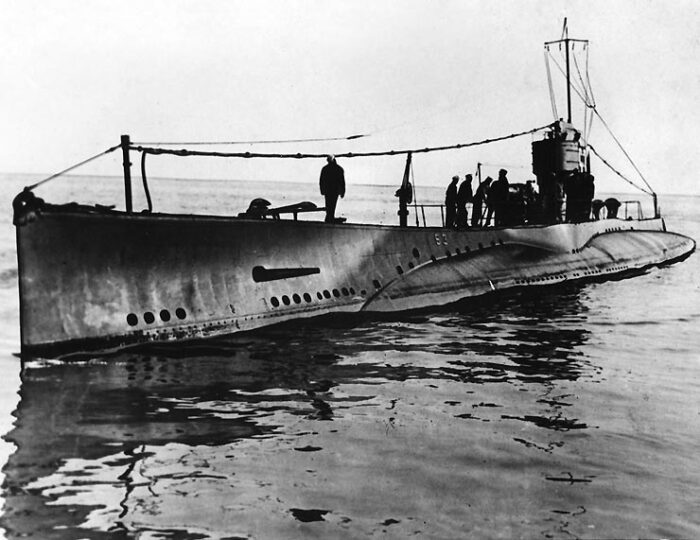
USS S-3 (SS-107) was the prototype of the “Government-type” S-class submarines of the United States Navy. (S-1 was the “Holland-type” prototype and S-2 the “Lake-type”.) Her keel was laid down on 29 August 1917 by the Portsmouth Navy Yard. She was launched on 21 December 1918 sponsored by Mrs. William L. Hill, and commissioned on 30 January 1919.
Following outfitting and trials, S-3 began her career with training operations along the New England coast operating out of Portsmouth and New London, Connecticut. In 1920, she twice visited Havana, Cuba: first in January, and again in December.
In July 1921, she was attached to Submarine Division 12 (SubDiv 12) which, along with SubDiv 18, was to rendezvous off Portsmouth for the longest voyage on record, at that time, for American submarines. The two divisions were assigned to the Asiatic Fleet as Submarine Flotilla 3 (SubFlot 3) at the Cavite Naval Station in the Philippine Islands. They sailed via the Panama Canal to Pearl Harbor, where S-3 was detached and reassigned to operate on the United States West Coast from Mare Island, California. The two divisions continued on and successfully completed the voyage, arriving at Cavite on 1 December.
S-3 departed Pearl Harbor on 9 November and sailed to the U.S. West Coast where she operated until mid-July 1923. On 17 July, she took departure from San Francisco Bay to retransit the Panama Canal en route to New London.
Reaching New London on 5 September, she was attached to SubDiv 2, Atlantic Fleet, and assigned experimental duty at the Submarine School at New London, assuming the duties of S-1, flagship of SubDiv 2, which was conducting special experiments with aircraft. During the remainder of 1923 and the years following, into 1927, she ranged the United States East Coast conducting training operations and evaluating new techniques in submarine development.
In July 1927, S-3 and S-1 formed SubDiv 4 and began a schedule which included operational cruises to the Panama Canal Zone in the spring months of 1928–1930. The remaining months of those years were spent in operations along the New England coast.
Early in 1931, S-3 was ordered to Philadelphia, Pennsylvania, for inactivation. She was decommissioned there on 24 March and laid up. She was struck from the Naval Vessel Register on 25 January 1937 and subsequently scrapped.
 S4 (1919, SS109)
S4 (1919, SS109)
S4 was built at Portsmouth N Yd, laid down on 12.1917, launched on 27.8.1919 and completed on 11.1919. She was stricken in January 1936.
 S5 (1919, SS110)
S5 (1919, SS110)
She was laid down on December 1917, launched on 10 October 1919 and completed on March 1920. She was foundered on 1 September 1920.
 S6 (1919, SS111)
S6 (1919, SS111)
She was laid down in January 1918, launched on 23.12.1919 and completed on May 1920. She was stricken in January 1937.
 S7 (1919, SS112)
S7 (1919, SS112)
She was laid down on January 1918, launched 5 Feb. 1920 and completed in July 1920. They were stricken in stricken 1.1937.
 S8 (1919, SS113)
S8 (1919, SS113)
She was laid down in November 1918, launched 21 April 1920, completed in October 1920, stricken 1.1937.
 S9 (1919, SS114)
S9 (1919, SS114)
She was laid down in January 1919, launched on 17 June 1920 and completed on February 1921. She was stricken in January 1937.
 S10 (1920, SS115)
S10 (1920, SS115)
She was laid down in 9.1919, launched on 1 Dec. 1920 and completed on 9.1922. Also stricken in Jan. 1936
 S11 (1919, SS116)
S11 (1919, SS116)
Laid down on Dec. 1919, launched 7 Feb. 1921 and completed in January 1923, stricken in October 1945.
 S12 (1921, SS117)
S12 (1921, SS117)
Laid down on Jan 1920, laid down 4 August 1921, launched in April 1923, stricken 5.1945
 S13 (1921, SS118)
S13 (1921, SS118)
Laid down on February 1920, launched on 20 October 1921 and completed in July 1923. Stricken 10.1945
 S14 (1919, SS119)
S14 (1919, SS119)
Built at Lake, Bridgeport, laid down on 12/1917, launched on 22.10.1919 and completed on 2.1921. Stricken 5.1945
 S15 (1920, SS120)
S15 (1920, SS120)
Lake boat, laid down on 12/1917, launched 8.3.1920 and completed in January 1921. Stricken 6.1946
 S16 (1918, SS121)
S16 (1918, SS121)
Lake boats, laid down in March 1918, launched 23 Dec. 1919, and completed on 12.1920. Stricken 10.1944
 S17 (1920, SS122)
S17 (1920, SS122)
Lake boat laid down on April 1918, launched 22 May 1920 and completed in March 1921. Stricken 11.1944.
Electric Boat type (Second Group):
Same remarks as above.
⚙ S class specs, Electric Boat II |
|
| Displacement | 497 long tons (505 t) surfaced 652 long tons (662 t) submerged |
| Dimensions | 175 ft x 16 ft 7 in x 13 ft 11 in (53 x 5.05 x 4.24 m) |
| Propulsion | 2× 500 hp (373 kW) Busch-Sulzer diesels, 2× 400 hp (298 kW) Diehl EM, 120-cell batt. |
| Speed | 14 knots (26 km/h; 16 mph) surfaced, 11.4 knots (21.1 km/h; 13.1 mph) submerged |
| Range surfaced/sub. | 4,700 nmi at 6.5 knots sufaced |
| Armament | 4× 21 inches* TTs (8 torpedoes), 3 in/50 deck gun |
| Test Depth | 200 ft (61 m) |
| Crew | 33 |
 S42 (1923, SS153)
S42 (1923, SS153)
S42 was laid down at Yard 1389 in Bethlehem, Quincy on December 1920, launched 30 April 1923 and completed in december 1924. Stricken 11.1945.
 S43 (1923, SS154)
S43 (1923, SS154)
S43 was laid down at Yard 1390 at Bethlehem, Quincy on December 1920, launched on 31 April 1923 and completed in December 1924. She was stricken in November 1945.
 S44 (1923, SS155)
S44 (1923, SS155)
S44 was laid down at Yard 1391 at Bethlehem, Quincy. She was laid down on Feb. 1921, launched on 27 Ovtober 1923 and completed in Feb. 1925. She was sunk on 7 October 1943.
 S45 (1923, SS156)
S45 (1923, SS156)
S45 was laid down at Yard 1392 in Bethlehem, Quincy on December 1920, launched on 26 June 1923 and completed on April, 1925. She was stricken in Nov. 1945
 S46 (1923, SS157)
S46 (1923, SS157)
S46 wa slaid down at yard 1393 in Bethlehem, Quincy on Feb. 1921, launched on 11 Sept. 1923 and completed in June 1925. She was stricken Nov. 1945
 S47 (1924, SS158)
S47 (1924, SS158)
S47 was laid down at yard 1394 in Bethlehem, Quincy on Feb. 1921, launched on 5 January 1924and completed in September 1925, actually the very last boat of this class. She was stricken loke her sisters in November 1945.
The 2nd Group Lake Type:
A said above, this class was just the forced adoption of the Bureau Design by the Lake Torpedo Boat Company after the pitiful results of the uique USS S2.
Just four boats were built, and they had a relatively short careers, being axed with the 1930 London Treaty limitations. So about ten years each.
⚙ S class specs, Lake Boat II |
|
| Displacement | 903 long tons surfaced 1230 long tons submerged |
| Dimensions | 240 ft x 21 ft 8 in x 13 ft 5 in (73.2 x 6.6 x 4.1 m) |
| Propulsion | 1800 hp 2x Busch-Sulzer diesels, 1500 hp (298 kW) 2x Diehl EM, 200-cell batt. |
| Speed | 14.5 knots surfaced, 11 knots submerged |
| Range surfaced/sub. | 5,900 nmi at 11 knots sufaced |
| Armament | 4× 21 inches TTs (12 torpedoes), 4 in/50 deck gun |
| Test Depth | 200 ft (61 m) |
| Crew | 38 |
 S48 (1921, SS159)
S48 (1921, SS159)
This was the ex-SS169, built at Lake, Bridgeport, laid down on 10/1920, launched on 26.2.1921, completed on 10.1922. stricken 9.1945
 S49 (1921, SS160)
S49 (1921, SS160)
This was the ex-SS170, laid down on 10/1920, launched on 23.4.1921 and completed on 6.1922. Stricken 3.1931
 S50 (1921, SS161)
S50 (1921, SS161)
Ex-SS171, laid down on March 1920, launched on 18 June 1921 and completed in May 1922. Stricken 3.1931
 S51 (1921, SS162)
S51 (1921, SS162)
Ex-SS172, laid down on 12/1919, launched on 20.8.1921 and completed in June 1922. She wa slost in a collision on 25 September 1925.
Read More/Src
Books
The Submarine Has No Friends: Friendly Fire Incidents Involving U.S subs Douglas E. Campbell, Charles R. Hinman
Blair, Clay (2000). Hitler’s U-Boat War: The Hunters 1939–1942. London: Cassell & Co.
Links
A VISUAL GUIDE TO THE S-CLASS SUBMARINES 1918-1945 PART 1: CONCEPT DEVELOPMENT
A VISUAL GUIDE TO THE S-CLASS SUBMARINES 1918-1945 PART 2: THE GOVERNMENT BOATS
pigboats.com/S-class
web.archive.org/pigboats.com/subs/s-boats.html
history.navy.mil s-1
navweaps.com/PreWWII torps
navweaps.com 3in-50
navypedia.org/ Navy Yard type
navypedia.org/ Electric Boat type
navypedia.org/ Lake type 1st group
navypedia.org/ Lake 2nd group
navypedia.org/ 2nd group subs
wiki S-class submarine
laststandonzombieisland.com luckier-sugars/
laststandonzombieisland.com/ tough-christmas
on laststandonzombieisland.com 2-million-fighting-monster/
commons.wikimedia.org/
naval-war.com/ s-class-submarine-2
uboat.net/ S1 class
uboat.net/ S4 class
uboat.net/a S3 class
uboat.net/ S48 class
uboat.net/ S42 class
navweaps.com/ armament WWI
https://www.navsource.org/archives/08/08131.htm
https://www.oneternalpatrol.com/uss-s-26-131.htm
https://web.archive.org/web/20090911042946/http://archive.rubicon-foundation.org/8200
https://www.history.navy.mil/research/library/online-reading-room/title-list-alphabetically/u/united-states-submarine-losses/s-26-ss-131.html
















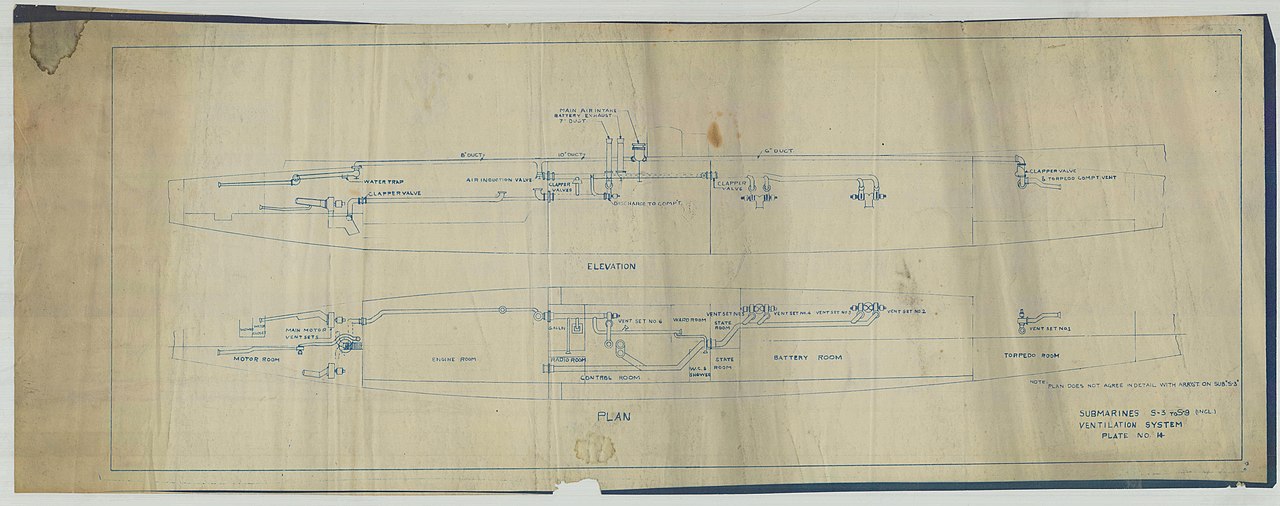
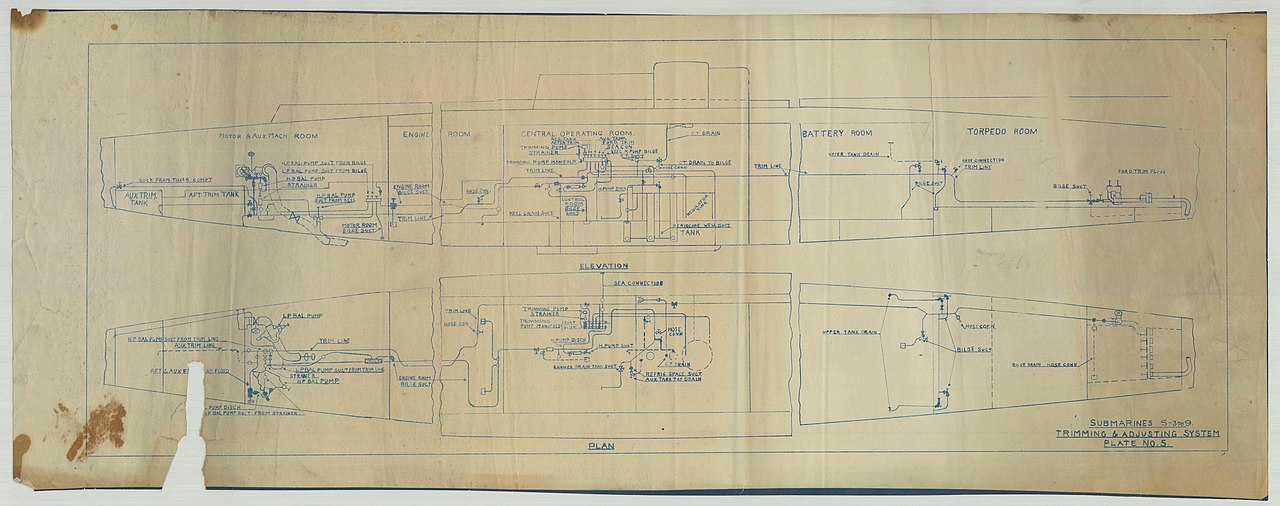
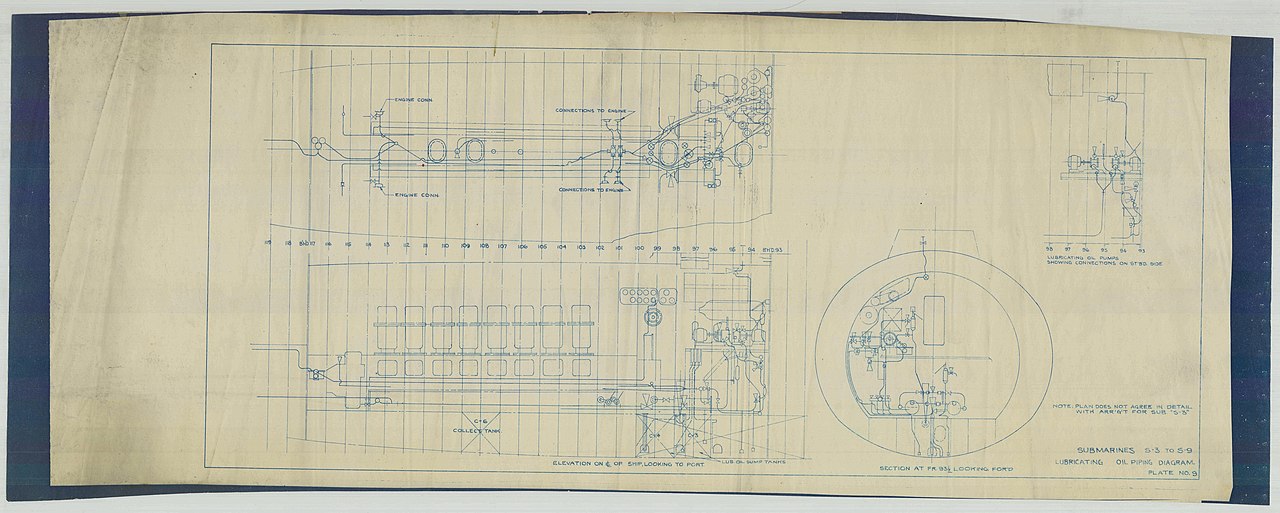
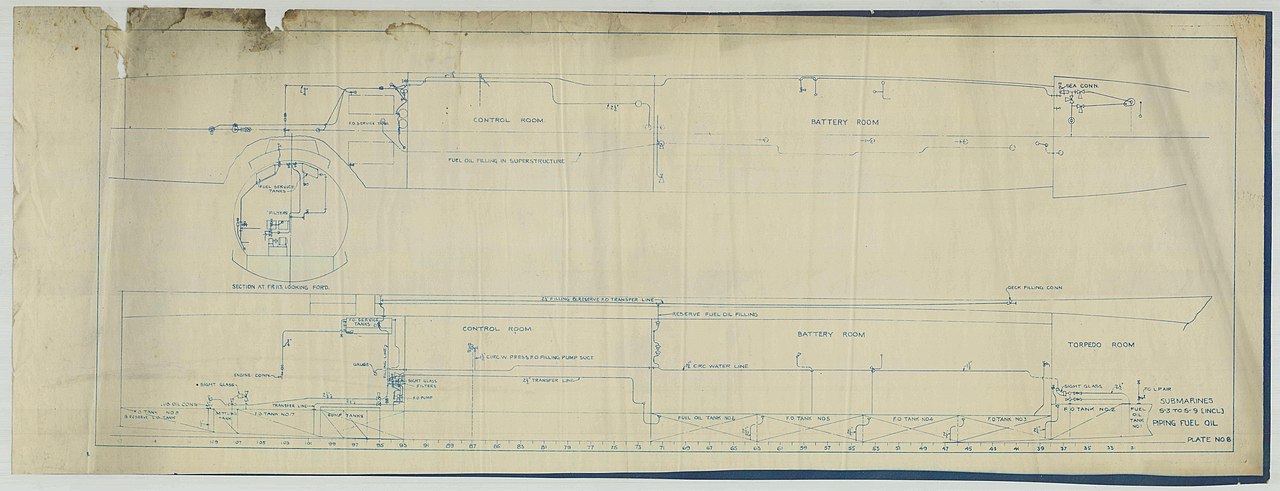
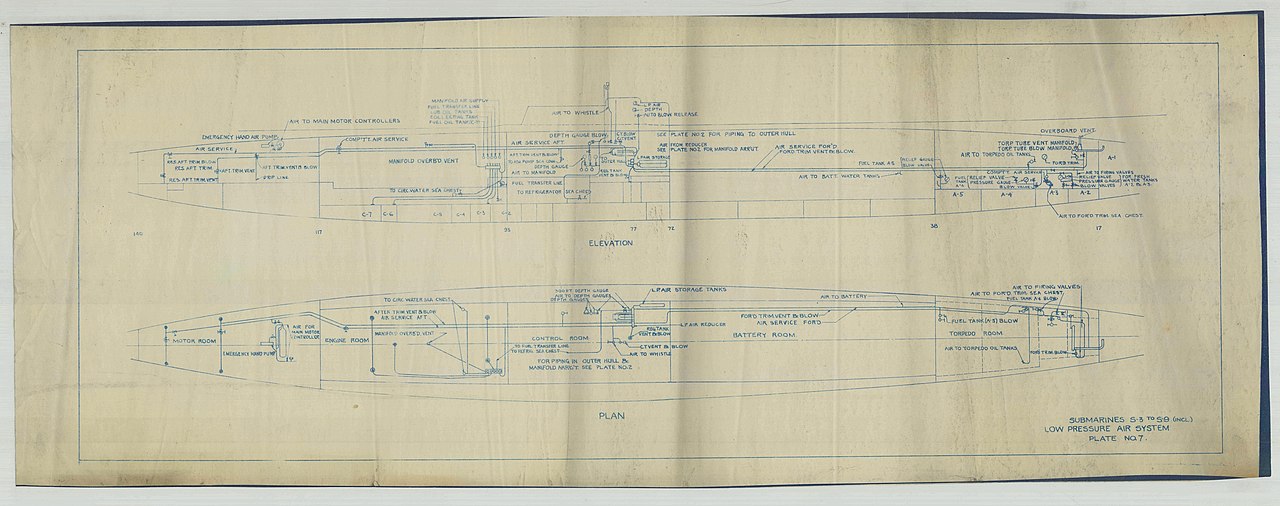
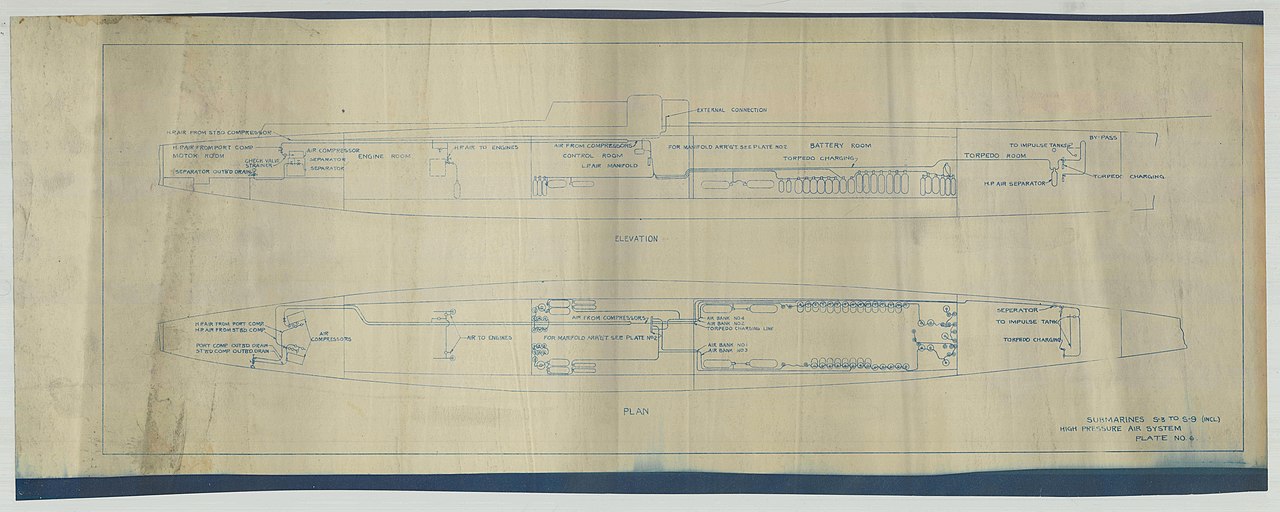
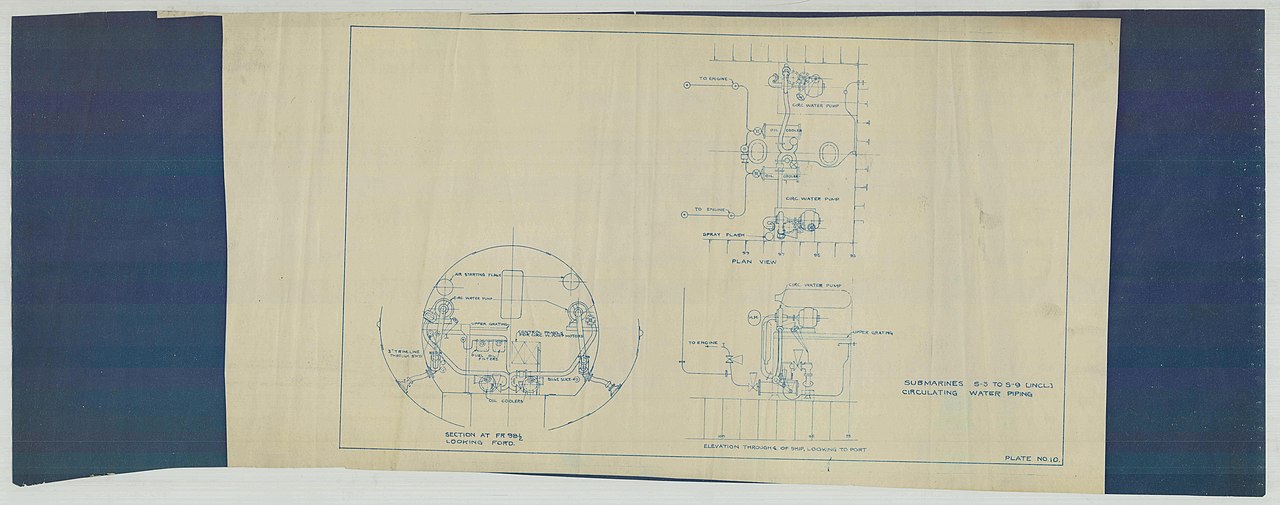
 Latest Facebook Entry -
Latest Facebook Entry -  X(Tweeter) Naval Encyclopedia's deck archive
X(Tweeter) Naval Encyclopedia's deck archive Instagram (@navalencyc)
Instagram (@navalencyc)





 French Navy
French Navy Royal Navy
Royal Navy Russian Navy
Russian Navy Armada Espanola
Armada Espanola Austrian Navy
Austrian Navy K.u.K. Kriegsmarine
K.u.K. Kriegsmarine Dansk Marine
Dansk Marine Nautiko Hellenon
Nautiko Hellenon Koninklije Marine 1870
Koninklije Marine 1870 Marinha do Brasil
Marinha do Brasil Osmanlı Donanması
Osmanlı Donanması Marina Do Peru
Marina Do Peru Marinha do Portugal
Marinha do Portugal Regia Marina 1870
Regia Marina 1870 Nihhon Kaigun 1870
Nihhon Kaigun 1870 Preußische Marine 1870
Preußische Marine 1870 Russkiy Flot 1870
Russkiy Flot 1870 Svenska marinen
Svenska marinen Søværnet
Søværnet Union Navy
Union Navy Confederate Navy
Confederate Navy Armada de Argentina
Armada de Argentina Imperial Chinese Navy
Imperial Chinese Navy Marinha do Portugal
Marinha do Portugal Mexico
Mexico Kaiserliche Marine
Kaiserliche Marine 1898 US Navy
1898 US Navy Sovietskiy Flot
Sovietskiy Flot Royal Canadian Navy
Royal Canadian Navy Royal Australian Navy
Royal Australian Navy RNZN Fleet
RNZN Fleet Chinese Navy 1937
Chinese Navy 1937 Kriegsmarine
Kriegsmarine Chilean Navy
Chilean Navy Danish Navy
Danish Navy Finnish Navy
Finnish Navy Hellenic Navy
Hellenic Navy Polish Navy
Polish Navy Romanian Navy
Romanian Navy Turkish Navy
Turkish Navy Royal Yugoslav Navy
Royal Yugoslav Navy Royal Thai Navy
Royal Thai Navy Minor Navies
Minor Navies Albania
Albania Austria
Austria Belgium
Belgium Columbia
Columbia Costa Rica
Costa Rica Cuba
Cuba Czechoslovakia
Czechoslovakia Dominican Republic
Dominican Republic Haiti
Haiti Hungary
Hungary Honduras
Honduras Estonia
Estonia Iceland
Iceland Eire
Eire Equador
Equador Iran
Iran Iraq
Iraq Latvia
Latvia Liberia
Liberia Lithuania
Lithuania Mandchukuo
Mandchukuo Morocco
Morocco Nicaragua
Nicaragua Persia
Persia San Salvador
San Salvador Sarawak
Sarawak Uruguay
Uruguay Venezuela
Venezuela Zanzibar
Zanzibar Warsaw Pact Navies
Warsaw Pact Navies Bulgaria
Bulgaria Hungary
Hungary

 Bundesmarine
Bundesmarine Dutch Navy
Dutch Navy Hellenic Navy
Hellenic Navy Marina Militare
Marina Militare Yugoslav Navy
Yugoslav Navy Chinese Navy
Chinese Navy Indian Navy
Indian Navy Indonesian Navy
Indonesian Navy JMSDF
JMSDF North Korean Navy
North Korean Navy Pakistani Navy
Pakistani Navy Philippines Navy
Philippines Navy ROKN
ROKN Rep. of Singapore Navy
Rep. of Singapore Navy Taiwanese Navy
Taiwanese Navy IDF Navy
IDF Navy Saudi Navy
Saudi Navy Royal New Zealand Navy
Royal New Zealand Navy Egyptian Navy
Egyptian Navy South African Navy
South African Navy






























 Ukrainian Navy
Ukrainian Navy dbodesign
dbodesign